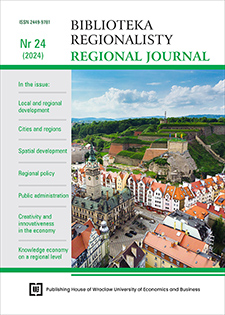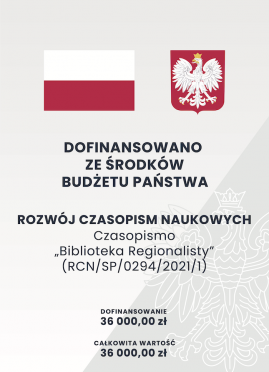Integrating port and social functions in urban public space: A case study of Port Węglowy in Wrocław
DOI:
https://doi.org/10.15611/br.2024.1.01Keywords:
yacht port , Port Węglowy, public space, social participation , WrocławAbstract
Aim: The study aimed to identify the needs and preferences of Wrocław residents regarding the development of Port Węglowy, the only yacht port in the city wholly owned and managed by the Municipality. The research focused on understanding residents’ vision for the area, assessing its current image, and exploring how the port could combine recreational, social, and port functions to enhance its value as a public space.
Methodology: The research used desk research of literature, legal documents, and press materials. An in-depth individual interview (IDI) was conducted with the river policy coordinator in Wrocław. An online survey (CAWI, n = 122) was also administered based on assumptions of the Project for Public Spaces organisation. The survey examined accessibility, comfort and image, functions and activities, and social value.
Results: The survey revealed limited awareness of Port Węglowy among Wrocław residents, with a significant portion expressing unfamiliarity with its location and purpose. Many respondents identified issues with accessibility, particularly regarding parking and pedestrian access. The majority of respondents wished to preserve the port character of the area. Preferred amenities included a small watercraft rental and a city beach, while land-based functions like food services and relaxation spaces were the most popular. Respondents generally rated the aesthetic quality of the port as average, with concerns about cleanliness and infrastructure.
Implications and recommendations: The findings underscore the potential of Port Węglowy as a multifunctional public space but highlight the need for broader public awareness and engagement. The lack of awareness about the port indicates an opportunity for the Municipality to connect residents more closely with this location, primarily through strategic marketing and community outreach. Recommendations to enhance Port Węglowy’s role as a social and recreational space connected with the port’s functions: 1. Conduct a public awareness campaign to increase knowledge and engagement around Port Węglowy. 2. Hold public consultations with diverse stakeholders, including local residents, city-wide users, and sailors, to ensure all stakeholders’ needs are addressed. 3. Improve accessibility, especially regarding parking and pedestrian routes, and enhance the overall aesthetic and functionality of the port area by introducing small-scale infrastructure. 4. Develop recreational facilities that align with residents’ preferences to increase the port’s social value and appeal. 5. Enhanced infrastructure and aesthetics.
Originality/value: This study contributes to the research on integrating port functions within urban public spaces, especially for smaller yacht ports like Port Węglowy in Wrocław. By focusing on resident perceptions and specific local needs, the research highlights the potential of yacht ports to serve as multifunctional spaces that combine social, recreational, and utilitarian roles within a city. The findings underscore the value of involving local communities in the planning and development of such spaces, providing insights that can guide future revitalisation projects in Wrocław and similar urban contexts.
Downloads
References
Adamiczka, H. (2023). Analysis of the utilization policy of Wrocław yacht harbors, marinas and river ports. Biblioteka Regionalisty. Regional Journal, 23, 1-10. https://doi.org/10.15611/br.2023.1.01
Bilski, M. (2015). Selected human factors in marina design. Procedia Manufacturing, 3, 1646-1653. https://doi.org/10.1016/j.promfg.2015.07.482
Den Hartog, H., Ding, F., Wang, X., & Wu, J. (2023). Waterfront revitalization as opportunity for sustainability transitions – the Huangpu River in Shanghai. In: Z. Allam (Ed.), Sustainable urban transitions. Urban Sustainability. Springer. https://doi.org/10.1007/978-981-99-2695-4_9
Gehl, J. (2012). Life between buildings: Using public space. Island Press.
Gehl, J., & Matan, A. (2009). Two perspectives on public spaces. Building Research & Information, 37(1), 106-109. https://doi.org/10.1080/09613210802519293
Gripaios, P., & Gripaios, R. (1995). The impact of a port on its local economy: The case of Plymouth The impact of a port on its local economy: the case. Maritime Policy & Management: The Flagship Journal of International Shipping and Port Research, 22(1), 13-23.
Kaźmierczak, R., Szczepańska, A., Grunwald, G., Kowalczyk, C., & Tanajewski, D. (2022). Conceptual framework of a Global Yacht Positioning System in Poland. Applied Geomatics, 14(1), 79-91. https://doi.org/10.1007/s12518-021-00413-z
Kochanowska, D. (1998). Przestrzeń publiczna – przestrzeń kulturowa miast portowych w transformacji. In: M. Kochanowski (Ed.) Współczesne metamorfozy miast portowych (pp. 45-54). Wydawnictwo Politechniki Gdańskiej.
Li, J., Li, X., & Zhu, R. (2023). Effects of ports on urban economic geography: A study based on the natural experiment of decentralization reform in China. Journal of Transport Geography, 111, article103624. https:/doi.org/10.1016/j.jtrangeo.2023.103624
Lonza, L., & Marolda, M. C. (2016). Ports as drivers of urban and regional growth. Transportation Research Procedia, 14, 25072516. https://doi.org/10.1016/j.trpro.2016.05.327
Lynch, K. (2011). Obraz miasta. Wydawnictwo Archiwolta.
Muszyńska-Jeleszyńska, D. (2013). Rozwój i rewitalizacja bydgoskiego węzła wodnego. Journal of Health Sciences, 3(14), 88-98.
OnWater.pl. (2015, December 12). Mapa Wrocławskiego Węzła Wodnego. https://onwater.pl/wroclawski-wezel-wodny-namapie/
Organisty, B. (2023a). Najpierw plaża miejska nad wodą, później marina. Wrocławski Park Wodny rusza z inwestycją. https://www.wroclaw.pl/sport/plaza-miejska-marina-port-weglowy-hydropilis-polinka-budowa-wizualizacje
Organisty, B. (2023b). W centrum Wrocławia działa nowy bar plenerowy – Beach Bar Port Węglowy. Byliśmy na otwarciu 31 maja. https://www.wroclaw.pl/sport/nowy-beach-bar-port-weglowy-otwarcie-menu-ceny-godziny-zdjecia
Rembarz, K. (2019). Port jachtowy jako element przestrzeni publicznej miasta nadmorskiego [doctoral dissertation, Politechnika Gdańska].
Rembarz, K. (2020). Możliwości wykorzystania infrastruktury portu jachtowego w procesie projektowania miejskiej przestrzeni publicznej. Przestrzeń, Ekonomia, Społeczeństwo, 18/II, 49-72.
Schneider-Skalska, G. (2012). Miasta nad wodą – dwie Wenecje. Czasopismo Techniczne. Architektura, 4(13) A, 103-116.
Urząd Statystyczny we Wrocławiu. (2023). Rocznik Statystyczny Wrocławia 2022. https://wroclaw.stat.gov.pl/publikacje-ifoldery/roczniki-statystyczne/rocznik-statystyczny-wroclawia-2022,3,16.html
Syahrir, Y. (2021). Towards an effective participatory process for a sustainable urban waterfront development. Communications in Humanities and Social Sciences, 1(1), 1-6. https://doi.org/10.21924/chss.1.1.2021.6
Traboulsi, C., Khalifa, M., El Samahy, E., El-Daghar, K., & Felix, M. (2023). Urban waterfront revitalization through landscape design enhancing social-cultural conditions of El-mina, Tripoli. Architecture and Planning Journal (APJ), 29(1), article 5. https://doi.org/10.54729/2789-8547.1189
Uchwała nr XXV/689/20 Rady Miejskiej Wrocławia z dnia 23 lipca 2020 r. w sprawie uchwalenia miejscowego planu zagospodarowania przestrzennego w rejonie wybrzeża Juliusza Słowackiego i ulicy Na Grobli we Wrocławiu. https://baw.um.wroc.pl/UrzadMiastaWroclawia/document/42289/Uchwala-XXV_689_20
What makes a successful place?. (n.d.). Project for Public Spaces. https://www.pps.org/article/grplacefeat
Downloads
Published
Issue
Section
License
Copyright (c) 2025 Hanna Adamiczka

This work is licensed under a Creative Commons Attribution-ShareAlike 4.0 International License.
Accepted 2024-12-06
Published 2025-01-31







